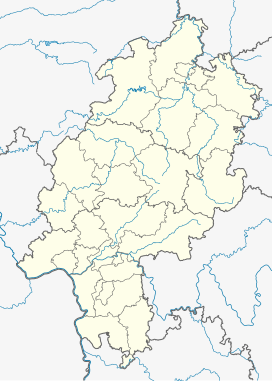Wasserkuppe
| Wasserkuppe | |
|---|---|
 |
|
| Highest point | |
| Elevation | 950.2 m above sea level (NN) (3,117 ft) |
| Prominence | 585 metres (1,919 ft) |
| Isolation | 60 kilometres (37 mi) |
| Coordinates | 50°29′53″N 9°56′16″E / 50.498056°N 9.937778°ECoordinates: 50°29′53″N 9°56′16″E / 50.498056°N 9.937778°E |
| Geography | |
| Parent range | Rhön (Hohe Rhön) |
| Geology | |
| Mountain type |
Basalt, Bunter extinct volcano |
| Climbing | |
| Easiest route | asphalt road almost to the top |
The Wasserkuppe is a mountain within the German state of Hesse. The (950 m (3,120 ft)) elevation, which is a large plateau formation, is the highest peak in the Rhön Mountains. Between the First and Second World Wars great advances in sailplane development took place on the mountain during the interwar period. Near the summit there is still an airfield used by gliding clubs and pilots of light aircraft.
The German name is derived from Wasenkuppe, Asenberg or Weideberg and means Pasture mountain.
The Wasserkuppe lies in the administrative district Fulda 5.3 kilometres (3.3 mi) north of Gersfeld. Other villages nearby are Poppenhausen (4.7 kilometres (2.9 mi) west - south west) and Wüstensachsen (5 kilometres (3.1 mi) east, part of Ehrenberg, Hesse). It is part of the Rhön Biosphere Reserve.
The Wasserkuppe sources the spring of the river Fulda (the western source of the Weser) and the river Lütter which joins the Fulda after 50 kilometres (31 mi).
The other peaks near the Wasserkuppe are Abtsrodaer Kuppe (north, 905 metres (2,969 ft) NN), Schafstein (east, 831.8 metres (2,729 ft) NN) and Pferdskopf (south west, 874.9 metres (2,870 ft) NN).
Students from the Darmstadt University of Technology, then known as Technische Hochschule Darmstadt, began flying gliders from the Wasserkuppe as early as 1911, but interest in gliding in Germany increased greatly after 1918 when the Treaty of Versailles restricted the production or use of powered aircraft in the nation. From 1920 onwards, annual gliding competitions were held, leading to records being set and broken for height, distance and duration of unpowered flight. In 1922 Arthur Martens became the first glider pilot to use an updraft rising along a mountain slope to stay aloft for a lengthy period. He then founded the world's first glider pilot school at the Wasserkuppe.
...
Wikipedia

